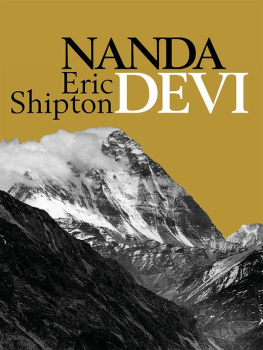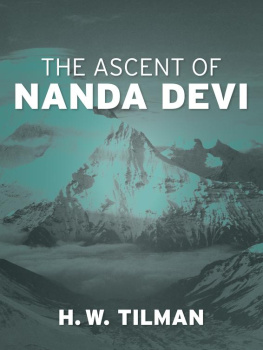SHIPTONS LEGACY FOR MOUNTAINEERS
by Stephen Venables
Eric Shipton was one of the great mountain explorers of the twentieth century. As a young climber he was brave and skilful, with a prodigious flair for pioneering new routes on remote peaks, far from any hope of rescue. During the course of his life that bold vision broadened to encompass immense landscapes and he was drawn increasingly to the wide canvas of exploration, with the result that we sometimes forget what a brilliant natural climber he was. However, whether we view him as an explorer, or climber, or both, his greatest achievement was to unlock the secrets of so many mountain ranges. The mountains he discovered - and the manner in which he discovered them remain an inspiration to all who have attempted to follow in his steps.
I first came across his name in 1972. I had just started climbing, I was filled with dreams of far off mountains and was devouring everything I could on the subject. One book in particular seemed to enshrine all my half-formed aspirations. It was Shiptons autobiography, That Untravelled World. Here was a man who had dared to follow his dreams and whose sense of enchantment sparkled from every page of unadorned prose.
Soon I got to know all the other books and followed Shiptons travels in more detail, discovering the intricacies of the Nanda Devi adventure, the repeated attempts on Everest and the breathtaking scope of the great Karakoram explorations told in my favourite of all, Blank on the Map. I couldnt afford to buy first editions and had to rely on borrowed library copies. So I was delighted when a new omnibus Eric Shipton: The Six Mountain-Travel Books assembled all his early narratives into a single affordable volume, complete with well-captioned photos, additional articles, clear maps, pertinent appendices and an eloquent Introduction by Jim Perrin. It remains a treasured and constantly rejuvenating source of inspiration.
Since first reading Shiptons books, I have got to know some of the people who actually climbed with him Scott Russell in the Karakoram, George Lowe and Charles Wylie in Nepal, John Earle in Patagonia. They all found him a delightful companion, a great conversationalist, an enthusiast but also a gently provocative rocker of the establishment. And its that same engaging personality that speaks through the books; they are immensely readable.
As Jim Perrin points out, the writings would be remarkable if only for their sheer geographical scope. From his astonishingly bold, assured, pioneering debut on Mount Kenya, to Everest, to Garhwal and the Karakoram, to Turkestan, to Patagonia, Shiptons explorations covered immense areas of wilderness. But it was the manner of those explorations that made them such a continuing inspiration to modern mountaineers. Few of us cover as much ground; none of us has equalled the record of the 1935 Everest reconnaissance expedition that made first ascents of twenty-two peaks over 20,000 feet; most of us would baulk at the frugality espoused by Shipton and his famously austere companion, Bill Tilman; but the ideal of achieving more with less, travelling uncluttered, attuned to the landscape remains an aspiration.
As Harold Evans famously pointed out, a picture can be worth a thousand words. It was Eric Shiptons 1937 photos of the Latok peaks, the Ogre and Uli Biaho that inspired the next generation. In a sense he threw down the gauntlet for John Roskelley, Doug Scott, Jim Donini and all those others who brought modern techniques to the soaring granite towers in what is now northern Pakistan. More recently the spire that bears Shiptons name has been a recurring magnet for modern American climbers like Greg Child, Mark Synott and Steph Davis. Shipton had the grand vision to reveal vast tracts of previously unexplored mountain country; his modern followers are enjoying the fruits whether it is the fine detail of a vertical rock tower or the broader sweep of the great Karakoram ski tours carried out by people like Ned Gillete, David Hamilton and the Odier brothers. For myself, with Phil Bartlett and Duncan Tunstall, it was thrilling, in 1987, to try and emulate Shipton, making a serendipitous first ascent above the Biafo Glacier, before continuing over Snow Lake to the same Khurdopin Pass he had reached with Scott Russell 48 years earlier, at the outbreak of the Second World War.
That war saw Russell incarcerated in the infamous Changi jail in Singapore, while Shipton languished more comfortably in one of the few proper jobs he ever had as British Consul in Kashgar. There he wrote his first volume of autobiography, Upon That Mountain. He ends the book on an elegiac note, describing his last evening on Snow Lake before returning to a civilization embarked on a cataclysmic war. The great granite spires of the Biafo stood black against a deep blue sky. At least this mountain world, to which I owed so much of life and happiness, would stand above the ruin of human hopes, the heritage of a saner generation of men.
Elegant prose from a man who, as Peter Steeles excellent 1998 biography revealed, was dyslexic and relied heavily on editorial help from some of his many girlfriends. If only some of todays celebrity adventurer authors could be given similar help. But its not just down to writing style. All too often the authors are simply ticking lists, notching up goals. With Shipton the journey was everything, the tantalizing view into an unknown cirque more important than the prestigious summit. Despite his obvious natural flair as a climber, he became increasingly drawn to the bigger picture, the far horizon. And by all accounts he could be hazy about logistical details. Hence the Everest putsch of 1952, when he lost the leadership of what was likely to be, finally, the successful expedition. The irony was that Shipton had taken part in more Everest expeditions than anyone else alive. As an outraged Charles Wylie pointed out, he was the man, he was Mr Everest. Of course, the replacement leader, John Hunt, was in his very different way just as charming and charismatic as Shipton, and he ran a brilliant show. But, as Hunt was the first to acknowledge, it was Shipton who had assembled his crack team, including the two New Zealanders, George Lowe and Ed Hillary, who both played such key roles in 1953. And it was Shipton who had, in 1935, first employed the aspiring young Tibetan, Tenzing Norgay.
Even the most selfless, unworldly saint would be aggrieved at losing his chance of global fame. Shipton had obviously thrilled to the opportunity, in 1951 and 1952, to be first into untouched country along the Nepal-Tibet border, all the way from Makalu to Menlungtse, but for a jobbing mountain lecturer and writer, success on Everest itself would have brought useful kudos. The sense of missed opportunity cannot have been helped by the subsequent break-up of his marriage. For a while he began to resemble a character from a Benjamin Britten opera an outcast, an oddball, a penniless misfit.
There the story might have ended, had it not been for the redemptive solace of mountain wilderness and the realization of new challenges. Like his former climbing partner Tilman, Shipton began a whole new career of exploration in the far south, rejuvenated by the stark empty spaces of Patagonia and Tierra del Fuego. And here again the world he explored has become a magnet for modern climbers. His gruelling first crossings of the great southern icecaps remain a template for todays sledge-haulers, including his younger son, John Shipton, who is increasingly following in his fathers steps. Likewise on Tierra del Fuego, where one of todays most imaginative and ascetic mountaineers, Andy Parkin and his frequent companion Simon Yates is drawn repeatedly to the mountain ranges Shipton first unravelled. And on the great spires of Cerro Torre and FitzRoy, virtuosos like Rolando Garibotti, Ermanno Salvaterra, Kelly Cordes and Colin Hayley still exemplify the Shipton ideal of travelling light, paring down, achieving more with less.










